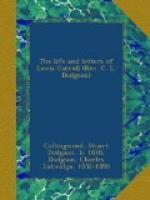I can say with a clear head and conscience [wrote Henry Kingsley] that your new book is the finest thing we have had since “Martin Chuzzlewit.” ... I can only say, in comparing the new “Alice” with the old, “this is a more excellent song than the other.” It is perfectly splendid, but you have, doubtless, heard that from other quarters. I lunch with Macmillan habitually, and he was in a terrible pickle about not having printed enough copies the other day.
Jabberwocky[017] was at once recognised as the best and most original thing in the book, though one fair correspondent of The Queen declared that it was a translation from the German! The late Dean of Rochester, Dr. Scott, writes about it to Mr. Dodgson as follows:—
Are we to suppose, after all, that the Saga of Jabberwocky is one of the universal heirlooms which the Aryan race at its dispersion carried with it from the great cradle of the family? You must really consult Max Mueller about this. It begins to be probable that the origo originalissima may be discovered in Sanscrit, and that we shall by and by have a Iabrivokaveda. The hero will turn out to be the Sun-god in one of his Avatars; and the Tumtum tree the great Ash Ygdrasil of the Scandinavian mythology.
In March, 1872, the late Mr. A.A. Vansittart, of Trinity College, Cambridge, translated the poem into Latin elegiacs. His rendering was printed, for private circulation only, I believe, several years later, but will probably be new to most of my readers. A careful comparison with the original shows the wonderful fidelity of this translation:—
“MORS IABROCHII”
Coesper[018]
erat: tunc lubriciles[019] ultravia circum
Urgebant
gyros gimbiculosque tophi;
Moestenui
visae borogovides ire meatu;
Et
profugi gemitus exgrabuere rathae.
O
fuge Iabrochium, sanguis meus![020] Ille recurvis
Unguibus,
estque avidis dentibus ille minax.
Ububae
fuge cautus avis vim, gnate! Neque unquam
Faedarpax
contra te frumiosus eat!
Vorpali
gladio juvenis succingitur: hostis
Manxumus
ad medium quaeritur usque diem:
Jamque
via fesso, sed plurima mente prementi,
Tumtumiae
frondis suaserat umbra moram.




